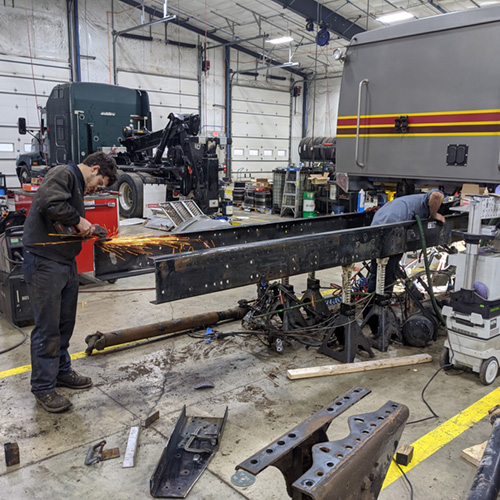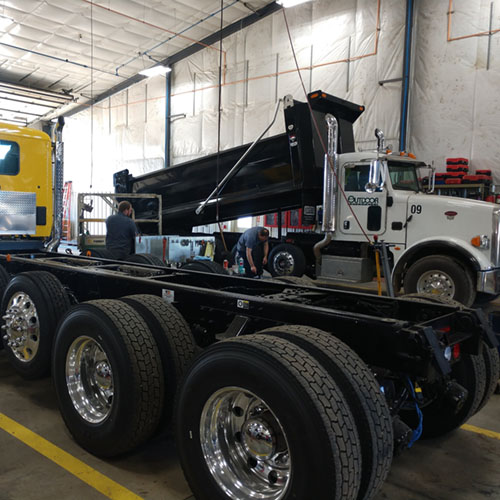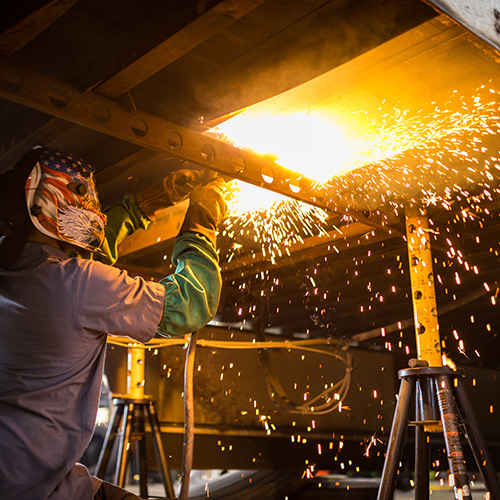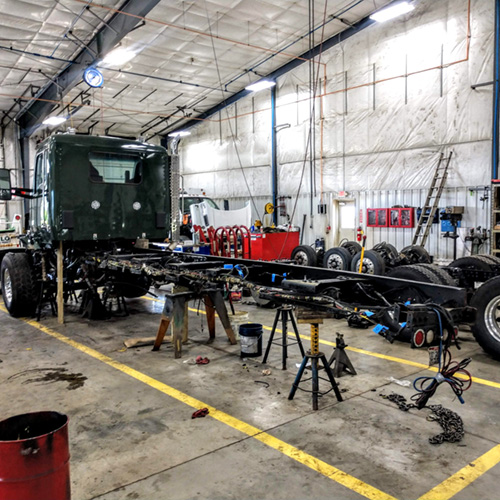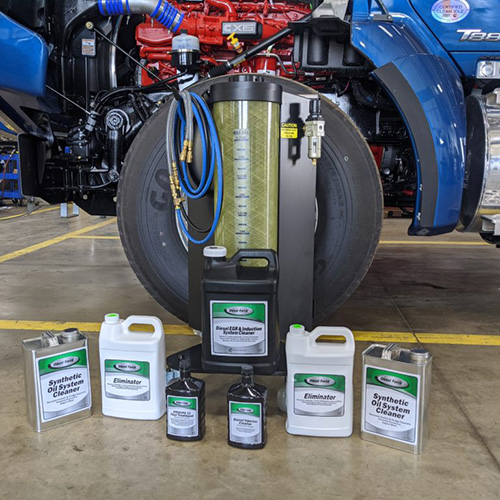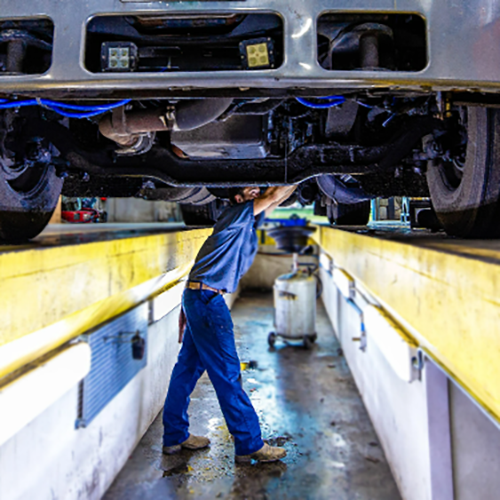Tips To Evaluate Frame Repair Damage On Semis & Dump Trucks
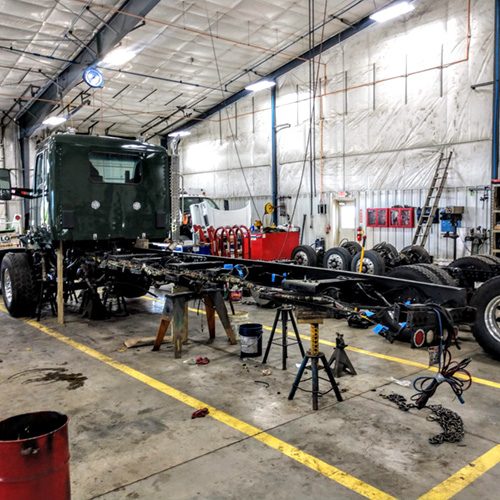
As a truck owner, you know your fleet’s proper maintenance is crucial for keeping your operators safe and profitable.
The frame rails on semis and dump trucks often sustain wear and tear over the years, so familiarity with frame repair damage assessment is essential.
In this blog post, we’ll walk through all aspects of evaluating frame repair damage and provide tips for understanding what to look out for in common areas of concern.
Table of Contents
Checking for Signs and Symptoms of Frame Damage
Visual Inspection
During a visual inspection, there are several signs and symptoms of frame damage that you should look for on semi trucks and dump trucks. These indications can help you identify potential issues and take necessary actions to address them. Here are three key areas to focus on:
- Visible Cracks, Dents, or Deformations: Carefully examine the frame for any visible cracks, dents, or deformations. These can be signs of structural damage, compromising the frame’s integrity. Pay close attention to areas around welds, joints, or high-stress points. Small cracks or deformations should not be ignored, as they can worsen over time and lead to more severe problems.
- Rust or Corrosion: Check for rust or corrosion on the frame, particularly in areas exposed to harsh conditions such as road salts, chemicals, or extreme weather, such as lap joints and frame welds. Past frame repairs using frame repair kits such as a fish plate would be a place of concern. Rust weakens the metal and can cause it to deteriorate over time. Look for bubbling paint or color change signs, indicating hidden surface rust. Also, check for swelling along the frame rail; rust can build up between the inner and outer frame rails, causing the outer rail to split. Rust will spread and compromise the frame’s structural integrity if left untreated.
- Alignment of Frame Components: Examine the alignment of frame components, including the rear axle, lift axles, and suspension mounts. Misaligned or unevenly spaced components can indicate frame damage. Look for any signs of uneven wear on tires or abnormal tire wear patterns, which can suggest misalignment of the axles at the rear or frame issues. Additionally, check if the doors, hood, or other body panels align correctly, as misalignment can result from frame damage.
Suspension Issues
Suspension issues can be indicative of frame damage on semis and dump trucks. By paying attention to the following signs and symptoms, you can evaluate whether there are potential frame problems:
- Abnormal Bouncing, Sagging, or Unevenness: When driving over bumps or uneven surfaces, observe if the vehicle experiences excessive bouncing or a noticeable sag in the suspension. These irregularities can suggest frame damage, as the frame plays a crucial role in supporting and maintaining the proper function of the suspension system. Any significant deviations from a smooth and controlled ride may cause concern.
- Vehicle Pulls to One Side: Another indicator of potential frame misalignment is when the vehicle consistently pulls to one side during everyday driving. This pulling sensation can result from an imbalanced frame, affecting the alignment and steering stability of the vehicle. It’s important to note that while other factors like tire pressure or wheel alignment can contribute to pulling, persistent pulling may warrant further investigation into frame alignment.
Handling and Steering Problems
Handling and steering problems are often attributed to damaged and rusted vehicle frames.
Here are two key signs to watch out for:
Excessive Vibrations or Shaking:
If you notice your vehicle experiencing abnormal vibrations or shaking while driving, it could indicate a rusted frame or frame damage.
A bent or rusted frame can affect the overall stability and balance of the vehicle, leading to these unsettling vibrations.
Difficulties in Steering Control:
Another potential consequence of a damaged or rusted frame is difficulties in steering control.
You may observe uneven steering response, where the vehicle feels unresponsive or pulls to one side.
Drifting, where the vehicle does not maintain a straight line while driving, can also indicate frame damage.
These steering issues can compromise your ability to maneuver your road vehicle safely. A professional technician should address them.
Remember, if you suspect frame damage or experience these handling and steering problems, it is crucial to consult a qualified technician to assess the extent of the damage and determine the necessary repairs.
Prompt attention to frame damage can help ensure the safety of the driver and passengers on the road.
Unusual Noises
Unusual noises on semis or heavy-duty trucks can sometimes indicate a damaged or rusty frame.
Here are some everyday noises to watch out for:
- Unusual Creaking Noises: If you hear unusual creaking noises while driving your truck, it could be a sign of frame damage. These noises may occur when the damaged frame is stressed, or the truck is going over bumps or uneven terrain.
- Excessive Vibration or Shaking: Experiencing excessive vibration or shaking in your truck could also indicate frame damage. A bent or damaged frame can affect the overall stability and balance of the vehicle, leading to these unsettling vibrations.
- Rattling or Knocking Sounds: Pay attention to any rattling or knocking sounds that were not noticeable before. These sounds may result from the damaged frame, causing parts of the truck to come into contact with each other or become loose.
Importance of Professional Inspection
Regarding semis and heavy-duty trucks, the importance of a professional frame inspection cannot be overstated.
Here’s why:
- Expertise and Specialized Equipment: A qualified technician has the knowledge, experience, and specialized equipment required to inspect frame damage thoroughly. They know what signs to look for, where to examine, and how to assess the frame’s condition accurately. Their expertise ensures a comprehensive evaluation.
- Identifying Hidden Damage: Frame damage isn’t always visible to the naked eye. It can be hidden beneath layers of paint or components. A professional frame inspection allows for a detailed examination, uncovering potential issues that may have gone unnoticed. This helps avoid future complications and ensures the structural integrity of the vehicle.
- Ensuring Safety and Performance: The frame is the backbone of any truck, providing structural support and stability. If there is frame damage, it can compromise the overall safety and performance of the vehicle. A professional inspection helps identify any weaknesses or vulnerabilities, allowing for timely repairs and ensuring optimal safety on the road.
- Preventing Costly Repairs: Detection of frame damage through a professional inspection can help prevent further deterioration and more significant repairs. Addressing any issues early on can save you from costly repairs and potentially extend the lifespan of your truck.
Remember, frame damage is no fun and can impact crucial components like suspension, steering, and braking systems.
Investing in a professional frame inspection provides peace of mind, knowing that your truck is in top-notch condition and ready to handle the demands of the road.
Steps to Evaluate Frame & Rust Repair
Consultation and Documentation
When evaluating frame repair damage on semis and heavy-duty trucks, it is essential to follow a systematic approach. Here are the initial steps to take:
Consultation:
Start by having a thorough consultation with the truck owner or operator.
Gather information about the vehicle’s history, including any previous accidents, repairs, or modifications.
This knowledge will help provide context and guide the inspection process.
Document the Current State:
Next, carefully document the current state of the frame damage. Take detailed notes and photographs that capture the extent and location of the damage.
This documentation is crucial evidence for insurance claims, repair estimates, and tracking progress.
- Notes: Describe the visible damage, including any signs of bending, cracks, or misalignment. Note specific areas where the damage is concentrated, such as the frame’s front, rear, or sides.
- Photographs: Capture pictures from multiple angles that depict the damaged areas. Ensure proper lighting and focus to provide a comprehensive visual record.
Consulting with the truck owner or operator and documenting the frame damage thoroughly establishes a solid foundation for the evaluation process.
These initial steps set the stage for further assessment and help guide the repair process.
Structural Integrity Assessment
Continuing the steps to evaluate frame repair damage on semis and heavy-duty trucks, we move on to assessing the structural integrity. Here are the following steps:
Utilize Advanced Diagnostic Tools:
Qualified technicians use advanced diagnostic tools to measure frame alignment accurately and identify structural weaknesses.
These tools include laser measuring systems, computerized frame alignment machines, and electronic measuring devices.
They provide precise measurements and aid in detecting any deviations or misalignments in the frame structure.
Conduct Non-Destructive Testing Methods:
Non-destructive testing methods are used to assess the internal condition of the frame without causing any further damage.
Two standard methods employed are:
- Ultrasonic Testing: This technique uses high-frequency sound waves to detect internal flaws, cracks, or hidden damage within the frame structure. It is beneficial for identifying issues that may not be visible on the surface.
- Magnetic Particle Inspection: This method involves the application of magnetic particles to the frame’s surface. Creating a magnetic field makes any cracks or defects in the material visible as the particles adhere to them. It helps identify potential weaknesses in the frame.
Technicians can comprehensively understand the frame’s structural integrity using advanced diagnostic tools and non-destructive testing methods.
These evaluations help determine the extent of the damage and guide the subsequent repair process.
Analyze Load Capacity and Stress Points
Continuing with the steps to evaluate frame repair damage on semis and heavy-duty trucks, we analyze load capacity and stress points.
Here are the following steps:
Evaluate Load-Bearing Capabilities:
Assessing how frame damage impacts the vehicle’s load-bearing capabilities is crucial. Consider the manufacturer’s specifications, weight ratings, and intended use of the truck.
Evaluate how the damage may affect the frame’s ability to support the required loads safely.
This evaluation helps determine if any structural repairs or reinforcements are necessary.
Analyze Stress Points:
Identify the stress points of the frame that may be affected by the damage.
Stress points are areas where the frame is subjected to higher forces or impacts during regular operation.
These points can include suspension mounting points, cross-members, and attachment points for additional equipment or payloads.
Analyze how the frame damage may compromise the integrity of these stress points and potentially lead to further issues.
- Suspension Mounting Points: Inspect the condition of the suspension mounts and connections to ensure they are not weakened or damaged due to frame issues.
- Cross-Members: Examine the cross-members for signs of bending or cracking, as they are crucial in distributing the load across the frame structure.
- Attachment Points: Check the attachment points for any signs of deformation or stress that may affect the secure installation of additional equipment or payload.
By evaluating the impact of frame damage on load capacity and analyzing stress points, technicians can determine the extent of repairs needed to ensure the truck’s safe operation under intended loads and conditions.
Repair Options and Considerations
Frame Repair vs. Replacement
When evaluating the type of damage to the frames of semis and heavy-duty trucks, it is essential to consider the repair options available to the types of frames you are working with. Here are the considerations for frame repair versus replacement:
Feasibility of Frame Repair:
Frame repair can be viable in specific scenarios where minor frame damage has occurred and does not compromise the frame’s structural integrity. These situations may include:
- Minor Bending or Misalignment: If the frame damage is limited to minor bending or misalignment, it may be possible to straighten and reinforce the affected areas using frame straighteners and frame repair kits.
- Small Cracks or Weld Failures: If the damage involves small cracks or weld failures, they can often be repaired by welding and replacing the affected part of the frame.
- Non-Critical Stress Points: If the frame damage is limited to non-critical stress points that do not affect the overall stability and safety of the vehicle. In this scenario, targeted repairs can be performed by qualified technicians.
It is essential to consult with experienced technicians specializing in frame repair to assess the feasibility and effectiveness of repairs based on the specific damage.
Necessity of Full Frame Replacement:
In severe cases of frame damage or when safety concerns arise, frame replacement may be the only way to go. Situations where frame replacement is likely include:
- Extensive Structural Damage: If the area of the frame damage is extensive, involving significant bending, cracking, or deformation, repair may not be feasible or cost-effective. In such cases, replacing the frame ensures the vehicle’s structural integrity.
- Compromised Load-Bearing Capabilities: If the damage affects the load-bearing capabilities of the frame beyond repair, frame replacement may be necessary to ensure the truck’s safe operation under intended loads.
- Safety Considerations: If the frame damage poses safety concerns, such as compromising critical stress points, attachment points, or suspension mounts, replacing the frame becomes crucial to maintaining the overall safety of the vehicle.
When determining whether frame repair or replacement is the best option, your best bet is to consult with qualified professionals who can assess the severity of the damage and provide expert guidance.
Choosing a Qualified Repair Facility
When choosing a qualified repair facility for semi and heavy-duty frame repair, it is crucial to consider several factors.
Here are some tips for selecting a reputable repair shop with experience in frame repair for heavy-duty trucks:
Look for Specialization:
Not all repair shops have expertise in heavy-duty truck frame repair.
Choosing a repair facility that specializes in handling frame repairs for these types of vehicles is essential.
Specialized knowledge and experience ensure that the technicians understand the unique challenges and requirements of repairing heavy-duty truck frames.
Check Certifications and Qualifications:
Certifications and qualifications are indicators of a repair shop’s commitment to quality and professionalism.
Look for ASE (Automotive Service Excellence) or manufacturer-specific certifications.
These certifications demonstrate that the repair facility has met specific standards and has technicians trained to work on heavy-duty truck frames.
Assess Experience and Track Record:
Consider the repair shop’s experience in handling frame repairs for heavy-duty trucks.
Look for established repair facilities with a track record of successfully repairing and restoring damaged frames.
Experience brings expertise and ensures the repair shop can effectively handle various types of frame damage.
Read Customer Reviews and Testimonials:
Customer reviews and testimonials provide valuable insights into the experiences of others who have used the repair shop’s services.
Look for reviews and testimonials specifically related to frame repair for heavy-duty trucks.
Positive feedback from satisfied customers is an indication of a reputable repair shop.
Inquire about Warranty and Guarantees:
A reliable repair shop stands behind its workmanship and may offer warranties or guarantees on the frame repair.
Inquire about the warranty terms and conditions to ensure that you are protected in case of any issues that may arise after the repair is completed.
Considering these tips, you can select a reputable repair shop with the necessary experience and expertise in frame repair for heavy-duty trucks.
Conclusion
In conclusion, evaluating frame repair damage on semis and dump trucks is critical for ensuring these heavy-duty vehicles’ safety and functionality.
By following the steps outlined in this blog, including analyzing load capacity and stress points, one can effectively assess the extent of damage and determine the necessary repairs or replacements.
When selecting a reputable repair shop, it is essential to consider the expertise of qualified repair facilities, certifications, and customer reviews.
With proper evaluation and careful decision-making, we can ensure that these valuable vehicles are restored to their optimal condition, providing reliable performance on the road.
Contact Wayne Truck & Trailer today and have our skilled technicians repair your semi or heavy-duty vehicle frame.

